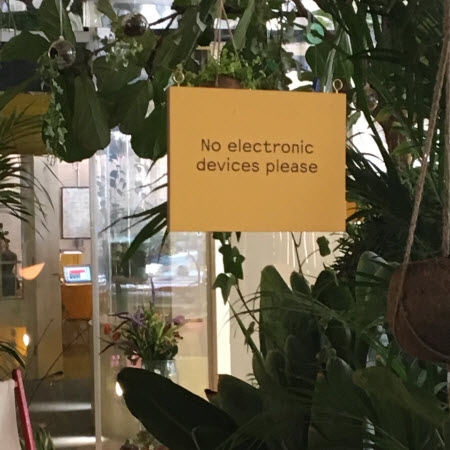
Last week, I was in London teaching social media strategy workshops for London NGOs organized by Social Media Misfits and keynoted Institute of Fundraising’s Future of Fundraising Conference. The workshops took place in different locations, including LinkedIn Headquarters in the UK, GA, and a co-working space called Second Home, a creative co-working space and cultural venue, bringing together diverse industries, disciplines and types of social businesses.
As a co-working space, if offers offices, desks, and meeting space for start ups. One thing you notice is the building interior design, created by award-winning Spanish architects SelgasCano. Many glass windows, winding hallways, and plants -lots of them – throughout the building. But what I really appreciated was the “meditation” or “quiet” spaces – electronic free zones where people can escape collaborative overload from back-to-back meetings and emails and collect their thoughts.
This is known as “brain breaks” where you simply STOP for a moment and do something to reset and renew your brain’s capacity to absorb or create that next thought. As many nonprofit professionals know too well, a hard-working but “tired” brain needs a few moments to “recharge.” An electronic free zone or quiet room can provide a good reminder to take these brain breaks. Even just getting up and walking around your desk can do the same.
But even when our brains are resting, according to research , our minds are perpetually active internalizing and evaluating information. When we are not actively doing tasks or taking information – and embracing silence, this is good for our brains because is enables reflection and creativity. Other students have found that sound noise (people talking, phones ringing, etc) can have a pronounced physical effect on our brains resulting in elevated levels of stress hormones. That’s why having quiet time in a quiet room can help hack your stress.
In the Happy Healthy Nonprofit, we discussed the importance of taking breaks from work and for nonprofits to encourage staff to take mini-breaks. The break helps boost productivity. It is also important to take tech breaks – or “Digital Detoxes”– and those can be also organization-wide activities to reduce staff stress and pressure. Some additional ways to cut down on employee’s digital stress beyond a device free zone in the workplace:
- Encourage good email communications guidelines such as brevity, clear asks, and clear subject lines.
- Set up internal chat lines for sharing photos or brief social updates.
- Encourage staff to stay off of email during the weekends or after hours.
- Use retreats as a time for digital detox – stay off email and devices during the retreat meeting.
How do you take a break during the workday? What reboots your brain? How does your nonprofit organization and its leaders encourage staff to take mini-breaks during the day?

Leave a Reply